- Contributors
- Subscribe Now

Kawasaki Voyager Xii

Kawasaki Voyager Xii May 1 1989
Kawasaki Voyager XII
CYCLE WORLD TEST
The smallest giant
MONUMENTAL WORDS OF INSIGHT SOMETIMES come at odd times and places. In this instance, it was at a filling station in the middle of the Mojave Desert. The speaker was looking at a road map, trying to figure the best way back to Los Angeles without getting lost, then he looked up and a totally unrelated thought struck him. "This might be the only Japanese bike to be less complicated than the model it replaced." The speaker was Feature Editor Jon Thompson, the bike was the Kawasaki Voyager XII, and the words were indisputably true.
Back in the early Eighties, Kawasaki had no idea what to do with the all-but-useless six-cylinder monsterbike it had developed. At the time, the only place that immense size seemed to be acceptable was the touring market. Fine. That's where the big 1300 went. In subsequent years, the Six was the subject of more size jokes than William “The Refrigerator” Perry.
Then along came 1986 and the Kawasaki Voyager XII. The 1200 was everything the 1 300 wasn't—namely small,> at least for a touring bike. And now. the 1989 1200. which is basically unchanged from the original model, is the only touring bike that Kawasaki officially offers, even though hardcore mass addicts can still find the discontinued Six at some dealers.
What's most interesting about the Voyager XII is that even though it has two less cylinders, even though it weighs 150 pounds less, and even though it has half the cubic stuff that the 1300 had, it seems to give away nothing. In fact, the 1 200’s engine is noticeably stronger than the I 300's. It produces more bottom-end power and revs out to a healthy mid-range. Both motors have a zippy, race-car exhaust note, but on the big Six, the engine always sounded like it was working way too hard. The XII has a lope-along mode that’s much more relaxing. And in that mode, engine vibration is all but unnoticeable. Oh. you can tell a slight difference between acceleration and coasting with the clutch pulled in. but you have to think about it some. The Voyager is still about as smooth as motorcycles get.
And the all-important list of touring items is about as long as you need. No matter how far you lean towards materialism, chances are you'll be satisfied by the XII. It has all the right stuff: an ÄM/FM cassette deck; an excellent cruise-control system; passenger speakers and controls for the stereo; píenty of storage. What it doesn't have is a decent tool kit—the one in a Honda Gold Wing, as poor as it is. puts the Kawasaki's to shame. It also doesn't have an onboard compressor for the suspension, or for any kind of inflatable seat-comfort-enhancing device. That, it could use. The XII's seat is thin and uncharacteristically low-ball—out of place on a top-of-the-line luxury tourer.
But then the seat on the old 1 300 was really never anything to get excited about, either. That's about the only thing the two have in common —Kawasaki really did succeed in its goal of making the 1200 as much unlike the 1300 as possible. With that goal in mind, it's easy to understand much about the 1 200. Kawasaki went overboard trying to make it small and maneuverable to compensate for the Six's problems. And it is the smallest, best-handling of the big touring bikes. Turning it requires virtually no effort at all—quite a change from the freight-train-like Six. In fact, cornering is so easy that you find yourself scraping footpegs w ithout really trying.
Conversely, holding the XII straight on a long, curveless freeway requires a little more concentration than it does on other big touring bikes. Just as soon as your thoughts start to wander and riding the bike becomes the secondmost-important thing on your mind, the bike takes the opportunity to make slow, lazy weaves in the lane.
While we're griping, we might as well mention the fairing. It offers protection that is merely OK compared to most of the others on the market. Basically, too much air finds its way around the fairing, despite the addition of small w'inglets on the outside edges of the fairing, a modification first made to the 1987-model XII.
It’s interesting to note that in Cycle Worlds June, 1 986, touring bike comparison test, we complained about virtually all the same things: the thinly padded seat, the slight weaving and the fairing’s air spill-over. In fact, Kawasaki has made only three major changes to the Voyager XII since then: the addition of passenger speakers, cruise control and the change to a champagne color. That's a shame. > because with the addition of a better fairing and seat, plus improved stability, the Voyager could lay claim to being the best touring bike in the country.
Instead, the Voyager now sits at the top of a much smaller nitch. With the Honda Gold Wing taking the six-cylinder approach, the Kawasaki is left as the smallest and lightest of the heavyweights. It’s also the cheapest—by over $1000. Compared to the old 1300, the XI1 goes to show you that sometimes you can make your best progress by taking a few steps back. Compared with some of the other more-finished tourers, though, it’s still a few steps behind. 0
SPECIFICATIONS
VOYAGER XII
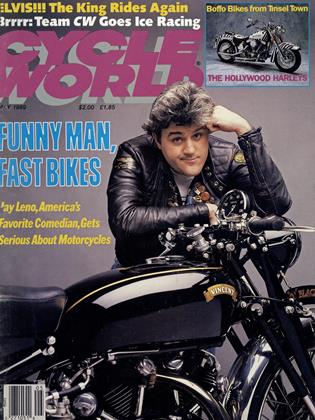
More From This Issue
Insurance blacklist dropped, harley-davidson goes topless, current subscribers can access the complete cycle world magazine archive register now, cycle world test.

Honda Cb650

Cagiva Wmx125

Harley-Davidson Xr1000
- cycleworld.com
Cycle World

Brief History Of The Kawasaki Voyager - One Of The First Japanese Touring Bikes
The Kawasaki Voyager was one of the first real Japanese touring bikes.
Before touring bikes became a thing, there were several aftermarket companies that made front fairings and hard cases. Most of the bikes fitted with those "accessories" looked like something out of a sci-fi movie. With odd angles and boxy designs, these were not great-looking bikes. The manufacturers took notice, though, and thankfully came up with their own more appealing designs. Most had minimal plastics, and you could still see the entire engine.
Honda started with the Silver Wing, which later grew into the ever-popular Gold Wing series . Yamaha had the Venture , and Suzuki’s attempt was the GS1100GK, which simply looked like a GS1100 with fairing and hard cases installed (because that is literally all it was). The Gold Wing and Voyager continued with great success and evolved into the touring bikes we know and love today. This is the history of the Kawasaki Voyager and how it went from an unusual in-line six to a modern V-twin today.
Related: 10 Reasons The Honda Gold Wing Needs To Be In Your Garage
The Kawasaki Voyager Started Life As A Big Six
Kawasaki went big with a 1286cc in-line six-cylinder engine which was equipped with digital fuel injection in 1984. That’s right,1984! The early voyager weighed in at 652 pounds and made 130 horsepower. The six-cylinder engine delivered smooth power throughout the rev range and was mated to a six-speed transmission. It also featured shaft drive to get all the power to the rear wheel, which was a skinny 130-90-17 back then. To get the tourer to stop, dual 260mm discs were placed up front and a 250mm disc in the rear. Most cruisers at that time still featured drum brakes in the rear. The ride was comfortable on long rides with 41mm equalized air forks at the front and dual rear shocks at the rear.
Back To An Inline-Four
In 1986, Kawasaki developed an inline-4 1196cc engine that produced 97 horsepower on a new, slightly heavier frame at 698 pounds. With less power and more weight, you would think that would be an issue. This is not the case. The lighter engine allowed the engineers to upgrade the frame design, suspension, and electronics and give it a unique look that lasted until production stopped in 2003. The engine also had hydraulic lifters for the valves, so no adjustment was ever needed. That was a big selling point; other models pretty much all needed adjustment at the time.
The downside was that they dropped the EFI and went with 30mm CVK carbs. In retrospect, they only gave problems when the bike sat for way too long (like any vehicle with a carb). They dropped sixth gear and opted for a 5-speed transmission, but they kept the shaft drive and went with a slightly wider rear tire (150-90-15).
Related: Fun Facts That You Should Know About The Kawasaki Versys 650
Why Change A Good Thing
The 86 model was designated the ZG1200A-1 model code, but the 87 model had some notable changes made to it, so they changed the designation to ZG1200B-1. It came with an MSRP of over $8,000. That design remained unchanged for seventeen years until the unit ZG1200B-17 was dropped from the lineup. It was one of the fastest tourers, had sturdy air-adjustable suspension, a tape player, and even CB radio were options. While the design was seriously dated by the 90s, Kawasaki didn’t see the need to change anything. Any changes would have made it more expensive, and at the time, units were selling out. So no there was no need to change the seemingly popular design. The Voyager XII had a cult following while the Gold Wing grew and along with more updates. The Kawasaki was still a lot cheaper, though, being almost $4,000 cheaper compared to other models in 2003 at $12,299.
The End Of The Kawasaki Voyager
For five years, Kawasaki had nothing in the touring market while the Gold Wing and Harley-Davidson models flourished. In 2009 Kawasaki released an all-new design developed from the ground up. The Vulcan 1700 Voyager was Kawasaki’s first V-Twin touring motorcycle ever. The big cruiser has a 1700cc fuel-injected engine that pumps out 73 horsepower . That is less than the Voyager XII, and at 895 pounds, it is also 197 pounds heavier. The rider won't feel that weight when they twist the throttle and the engine rumbles in response. It is most at home going straight at highway speeds, which is important for a touring bike. With the new Vulcan Voyager, the name will live on.
Related: 10 Reasons Why The Kawasaki Vulcan 1700 Voyager Is Criminally Underrated
The Latest Voyager
The 2023 Vulcan 1700 Voyager retails for $19,299. For fifteen years, it remained largely unchanged, with minor improvements in function, looks, and safety. With a wide 130 tire up front and a 170 in rear combined with 300mm disc for stopping power. The Voyager is a well-balanced touring bike with large 45mm forks that soak up the bumps far better than the old bike. Riding two up is not a problem, and as always, the passenger seat is well-thought-out. The new Voyager has some of the best electronics and is one of the most customizable bikes on the market with a big aftermarket. This model is in its fifteenth year now and will most likely surpass the seventeen-year mark of the original Voyager XII. The voyage is the most important part of riding to a destination, and it seems the Kawasaki Voyager will see many more destinations.
Kawasaki ZG1200 Voyager XII
Engine [ edit | edit source ].
The engine was a Liquid cooled cooled Four stroke transverse four cylinder. DOHC, 4 valve per cylinder. The engine featured a 10.0:1 compression ratio .
Chassis [ edit | edit source ]
It came with a 130/90-16 front tire and a 150/90-15 rear tire. Stopping was achieved via 2x 260mm discs 2 piston calipers in the front and a Single 250mm disc in the rear. The front suspension was a 41mm equalized air fork with remote filler while the rear was equipped with a Equalized air shocks with remote filler and adjustable rebound damping. The ZG1200 Voyager XII was fitted with a 23 Liters / 6.1 US gal fuel tank. The bike weighed just 317 kg / 698.9 lbs. The wheelbase was 1,620 mm / 63.8 in long.
Photos [ edit | edit source ]
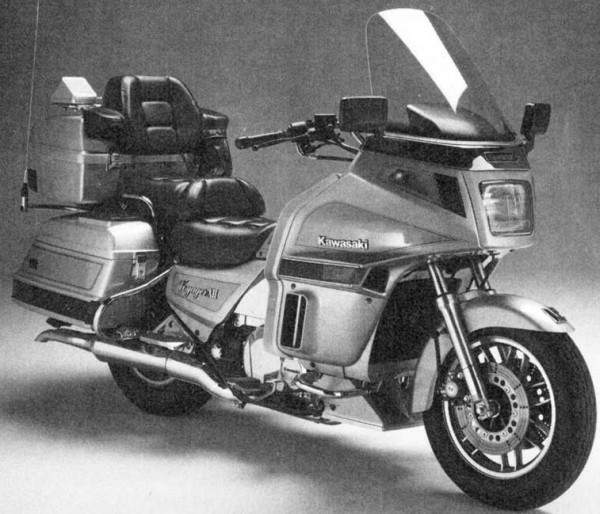
Overview [ edit | edit source ]
Kawasaki ZG 1200 Voyager XII
Touring riders are supposed to be rich as Midas, with saddlebags full of money they're practically panting to spend. Maybe so, but for those of us with buying power a few clicks down, Kawasaki offers its Voyager. If you want proof by the numbers, try these figures on for size: At $8700, the Voyager is $1100 less expensive than the next priciest tourer, Yamaha's Venture; $2800 less than Honda's GL1500; and a whopping $4300 less than Harley-Davidson's FLHTC Ultra Classic. Kawasaki's Voyager is also the quickest in its class. The liquid-cooled, 16-valve, five-speed inline-four provides acceleration both from 0 to 60 mph and through the quarter-mile that whips every other big-rig tourer. It complements that impressive speed with an almost ethereal smoothness (courtesy of twin gear-driven counterbalancers), a broad powerband, tack-sharp carburetion and instantaneous throttle response. The Voyager's the class lightweight, tooat least of the big Japanese tourers. Only Harley's FLTC and FLHTC and BMW's K100LT scale under the Kawasaki's 803-pound wet weight. But then, the Voyager entered the high-stakes touring game in 1986 with those attributes, as the quickest, least expensive and one of the lightest. Not much has changed since then. In 1987 the Voyager gained a cruise control, rear speakers for the AM/FM cassette deck, winglets on the fairing's trailing edges and different paint. Otherwise, the firm's flagship tourer remains the same, with steel-tube frame, triple-disc brakes, manually adjustable suspension, 16-inch front and 15-inch rear wheels, hydraulically adjusted valves and a multitude of adjustments for rider and passenger accommodations. Out on the superslab, in the land of chicken fried steaks and bottomless cups of coffee, a rider rarely feels he's had to give up much of consequence in trade for the Voyager's bargain-basement price. The fairing offers good wind protection for average-height riders, the riding position is roomy and relaxed and, set in the lower range of its adjustment, the suspension lets the bike fairly float over a wide variety of road surfaces. There's abundant small-item storage, the stereo offers decent sound quality plus a host of adjustments to amuse the rider, and the cruise control works competently, exhibiting only a slight jerkiness in maintaining speed on downhills. Still, there are shortcomings, and first among them is the saddle. The soft, thin padding practically guarantees you'll be ready to take a break well before the bike runs through its 6.1-gallon fuel supply. The Voyager lacks a particularly refined sense of straightline stability, too. The Dunlop Gold Seal F21 front tire follows rain grooves and pavement ruts, and even on a smooth surface the bike wanders slightly. And a passenger will complain about both a shortage of weather protection and a surfeit of wind noise. Once a rider reaches the bright lights of the big city, he'll be thankful he's not paying for some things most other tourers have aplenty; namely, weight and clumsy low-speed handling. The low mass, 16-inch front wheel and tillerlike handlebars help yield remarkably light, quick steering, making the Voyager one of the most agile touring bikes at slow speeds. That same steering quickness, though, exacts a penalty. It's tough to maintain a precise course at slightly more than a walking pace, especially if the bike's burdened with a full load and passenger. Many of those traits characterize the Voyager's twisty road behavior as well. The bike feels nimble, with slot-car steering response that gets it in and out of corners quickly. Such assets help rank Kawasaki's Voyageragainnear the top among touring bikes for back road handling. Still, a rider needs to exercise a gentle hand at the helm. Flicking the bike into turns makes the front end feel rubbery, and discourages further exploration of the rather limited cornering clearance; the footpegs touch down first and at a lesser lean angle than almost any other modern motorcycle. For a solo rider, setting the suspension to eight psi in the front, 25 psi in the rear (5.7 to 8.5 psi and 21 to 36 psi are the suggested ranges, front and rear) and clicking the shocks' rebound damping to the fourth of their four adjustments gives the best compromise for ride and handling.
Unfortunately, the Voyager's lengthy roster of bests and mosts is accompanied by a similarly long list of annoyances. Of all the available adjustments to the handlebars, trunk, passenger saddle and windscreen height, only the bars offer any useful range. Anything but the farthest rearward position for the trunk and saddle cramps riders and passengers of average size, and the same riders end up looking through the top edge of the screen at its lowest position. Moreover, the narrow saddlebag openings force you to jam the bag liners in as if you were stuffing a turkey, and the stereo's main controls are too small for use with heavy gloves. Balancing that list are the easy-to-use two-stage mainstand, and the quick-detach saddlebags. What's important to remember is that many of the Voyager's faults are largely inconveniences, and not due to the bike's fundamental approach to touringone of low-buck; not low-ball. This motorcycle takes the basic touring-bike formula and folds in a generous mixture of speed, light weight and agility. For the rider who wants a full measure of amenities for the long haul, but who has to hold onto a dollar until that eagle grins, Kawasaki's Voyager still represents a sound investment. Source Cycle Magazine of 1986{| class="wikitable" |- !Make Model |Kawasaki ZG 1200 Voyager XII |- !Year |1986 - 88 |- !Engine Type |Four stroke transverse four cylinder. DOHC, 4 valve per cylinder |- !Displacement |1196 cc / 72.9 cu-in |- !Bore X Stroke |78 x 62.6 mm |- !Cooling System |Liquid cooled |- !Compression |10.0:1 |- !Lubrication |Wet, Multi-disc, Manual |- !Induction |4x Keihin CVK30 carburetors |- !Ignition |Electronic with vacuum advance |- !Starting |Electric |- !Max Power |97 hp / 72.3 kW @ 7000 rpm |- !Max Torque |11.0 kgf-m / 79.5 lb-ft @ 5000 rpm |- !Transmission |5 Speed |- !Final Drive |Shaft |- !Front Suspension |41mm equalized air fork with remote filler |- !Front Wheel Travel |140 mm / |- !Rear Suspension |Equalized air shocks with remote filler and adjustable rebound damping |- !Rear Wheel Travel |100 mm / 3.9 in |- !Front Brakes |2x 260mm discs 2 piston calipers |- !Rear Brakes |Single 250mm disc |- !Front Tire |130/90-16 |- !Rear Tire |150/90-15 |- !Wheelbase |1,620 mm / 63.8 in |- !Seat Height |755 mm / 29.7 in |- !Ground Clearance |140 mm / 5.5 in |- !Dry Weight |317 kg / 698.9 lbs |- !Fuel Capacity |23 Liters / 6.1 US gal
Videos [ edit | edit source ]
- Touring motorcycles
- Kawasaki motorcycles
Navigation menu

Help me MotorcycleZombies, you're my only hope!
Kawasaki Voyager 1200 Specs, Manuals, & Info
Taking care of a task for your license or motorcycle? Be prepared to satisfy any motorcycle insurance requirements.
Please enter your ZIP to get your insurance quote.
If you’ve got a Voyager 1200 that you’re working on, you’ve come to the right place.
Whether you’re doing a full rebuild or restoration motorcycle project or you just need to complete some routine maintenance, we’ve got all the information and links to what you need to do the job right.
On this page you’ll find:
- Links to the motorcycle service manual for your Voyager 1200.
- Where you can find used Voyager 1200s for sale to start a new motorcycle project or get a parts bike.
- Specs, details, and information about the history of the Voyager 1200.
MotorcycleZombies.com may earn an affiliate commission when you make a purchase through the links on this page.

Voyager 1200 Specs & Details
The Voyager 1200, also known as the ZG1200 or Voyager XI/XII, was a touring motorcycle produced by Kawasaki from 1986 to 2003.
Specs for the Kawasaki Voyager 1200 include:
- Engine Displacement : 1196cc
- Cylinders/Engine Type: Transverse four cylinder liquid cool DOHC 4 stroke.
- Compression Ratio : 10:1
- Transmission : 6 speed
- Wet Weight: 698 lbs
Find a Voyager 1200 for Sale Near You
If you’re looking for a Voyager 1200 of your own or need a donor parts bike for your current motorcycle project, you can use the MotorcycleZombies.com used bike search tool to find what you’re looking for.
Click your state below to find used Voyager 1200s near you.
These motorcycle search engines search Craigslist listing for the entire state so you don’t have to individually search each specific region.
Connecticut
Massachusetts
Mississippi
New Hampshire
North Carolina
North Dakota
Pennsylvania
Rhode Island
South Carolina
South Dakota
Washington DC
West Virginia
Once you’ve got the bike up and running, be sure to check back to our motorcycle registration and title guides if you need help getting plates (Especially if you’ve bought the Voyager 1200 without a title ).
Leave a Reply Cancel reply
Your email address will not be published. Required fields are marked *
Save my name, email, and website in this browser for the next time I comment.
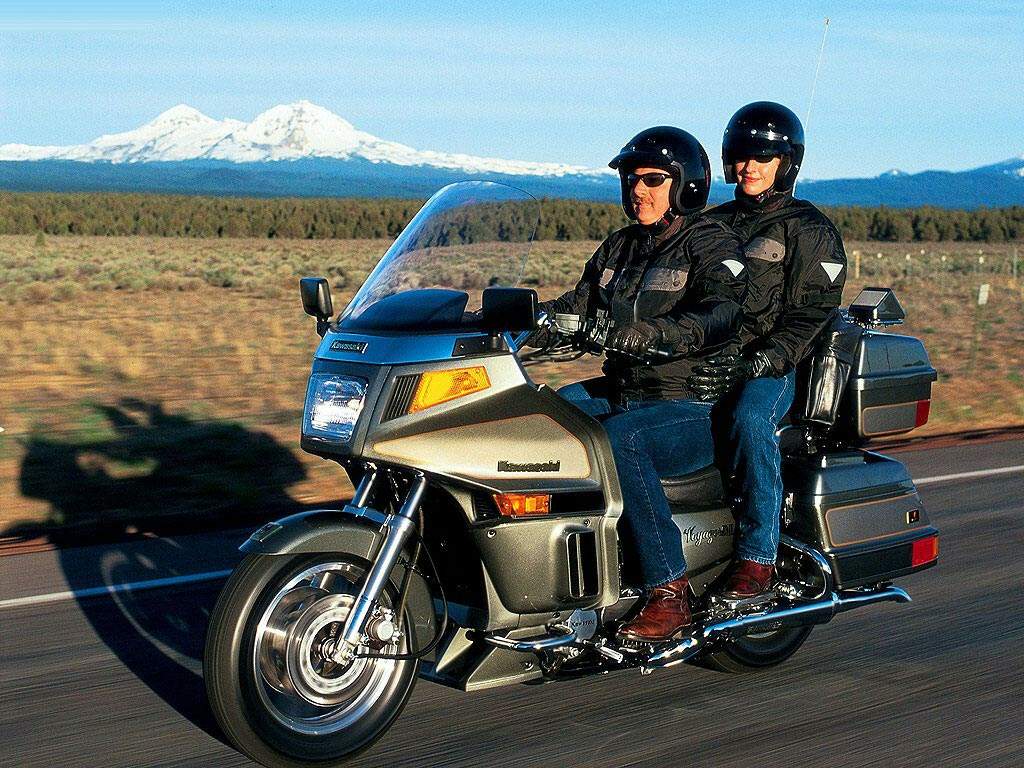
The Blue Ridge ParkWay is gorgeous in summer. So why not go? You’ll want to, when there’s a Kawasaki Voyager® XII waiting in the garage. So pack the top-loading saddlebags and trunk. Then start up the 1,196cc In-Line Four DOHC engine, settle in behind the aerodynamic fairing and let dual gear-driven engine balancers and fully adjustable suspension provide an incredibly smooth ride. And head the Voyager XII toward the ParkWay’s 469 miles of motorcycling paradise.
Long, relaxing days in the saddle are what the Kawasaki Voyager® XII motorcycle was built for. This machine lays claim to all of the features of a luxury tourer, from its spacious saddlebags and large rear trunk to its massive full fairing with wide windshield and deeply cushioned seat that's good for all-day cruising comfort. Passengers also benefit from an equally comfortable seating position, with grab rails, their own floorboards and an adjustable backrest. Truly, the Voyager pampers all of its riders.
- With standard features like electronic cruise control and a high-quality 4-speaker, AM-FM cassette stereo with dual remote controls, this land is your land to enjoy. - The extra strong Voyager XII powerplant delivers dependable touring power for effortless over- taking or hauling heavy loads up high-altitude mountain passes. - Dual integrated balancers plus rubberized engine mounts make the massive 1,196cc DOHC In-Line Four cylinder engine purr along smoothly. - Meticulous attention to keeping maintenance chores to a minimum: Reliable vacuum-advance electronic ignition. Automatic cam chain adjuster. Hydraulically controlled automatic valve lash adjusters. - Clean, quiet shaft final drive. - Making the Voyager fit you is easy: Air-adjustable front and rear suspension. Individually adjustable rider’s seat. Adjustable passenger backrest. Adjustable windshield. Adjustable handlebars. - Delivering extended touring range from the 6.1-gallon fuel tank is an ‘overdrive’ top gear. - The full coverage fairing knifes through the air and leaves both the rider and passenger in a cocoon of calm and quiet. - Luggage capacity is one of the Voyager’s strong points: The dual top-loading saddlebags complement the huge trunk. - The specially designed, dual-lever center-stand makes parking as easy as one, two...
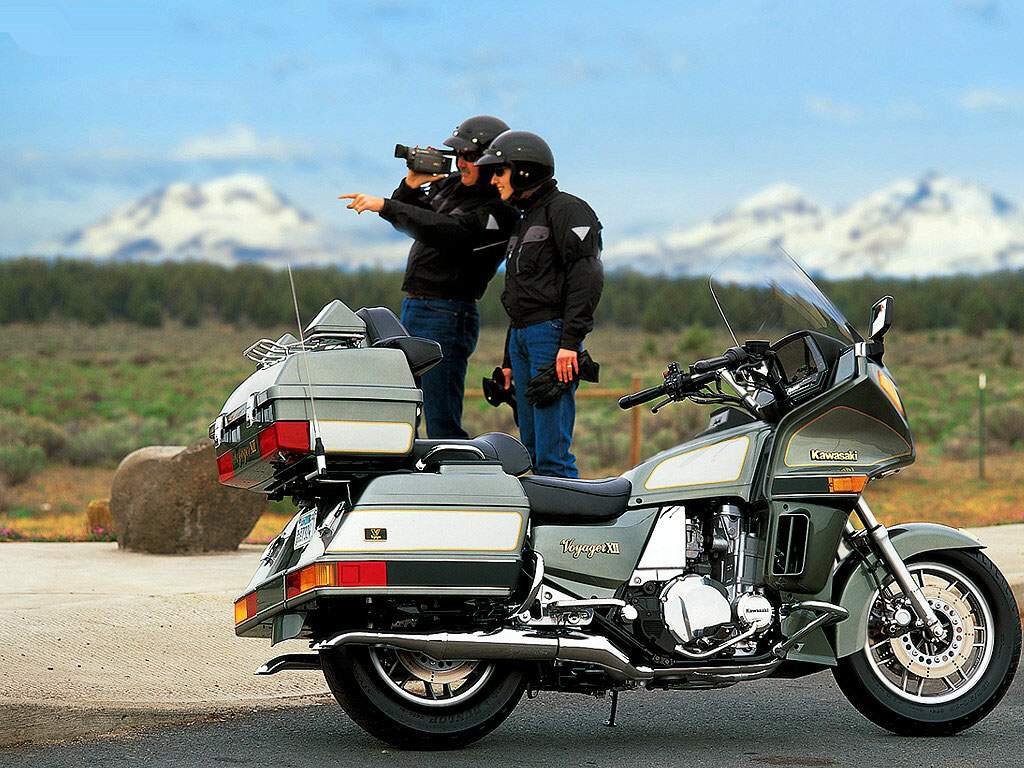

Kawasaki ZN1300 Voyager: review, history, specs
Class: tourer
Production: 1983-1988
Also called: Kawasaki Voyager 1300, Kawasaki Voyager XIII
Related: Kawasaki KZ1300
Successor: Kawasaki ZG1200 Voyager
Specifications
Kawasaki ZN1300 Voyager: specs.
Kawasaki ZN1300 Voyager: images, gallery.
Kawasaki ZN1300 Voyager: video.
Kawasaki ZN1300 Voyager: manuals, parts, microfiches.
- Kawasaki ZN1300 Voyager: Owners Manual
- Kawasaki KZ1300: Service Manual
Kawasaki ZG 1200 Voyager XII (1986-88) technical specifications
Kawasaki ZG 1200 Voyager XII is produced in 1986-88. Engine is Four stroke transverse four cylinder. DOHC, 4 valve per cylinder, displacement 1196 cc / 72.9 cu-in , produces power 97 hp / 72.3 kW @ 7000 rpm and 11.0 kgf-m / 79.5 lb-ft @ 5000 rpm. Kawasaki ZG 1200 Voyager XII weighs 317 kg / 698.9 lbs. Kawasaki ZG 1200 Voyager XII has 1 photos.
Technical specifications
Riders reviews.
Reviews score
Compare bike.

Moto-data World

Kawasaki ZG1200 Voyager, 2003
- General information
- similar models

Specifications
Similar models.
- ten best motorcycles
- new motorcycles
- motorcycle dyno
- buyer's guide
- comparison tests
- gear and products
- Buyer's Guide
2020 Kawasaki Vulcan 1700 Voyager
Kawasaki’s most expensive touring-ready cruiser.
A roamer, a city-hopper, and—you guessed it—a voyager. The Kawasaki Vulcan 1700 Voyager takes the comforts of the cruise and pairs it with a long-stroke 1,700cc V-twin with peak torque low in the rev range—that’s a claimed 108.0 pound-feet at 2,750 rpm. Its touring comforts include cruise control, integrated luggage (claimed two-helmet capacity) with passenger backrest, and a frame-mounted touring fairing. The Vulcan 1700 Voyager is Team Green’s take on cruising.
2020 Kawasaki Vulcan 1700 Voyager Reviews, Comparisons, And Competition
American competition for this big boy tourer include the Harley-Davidson Road Glide Limited , Ultra Limited , and CVO Limited and the Indian Roadmaster . Japanese tourers include the Yamaha Star Venture and Honda Gold Wing .
Kawasaki Vulcan 1700 Voyager Updates For 2020
The only colorway available is Metallic Phantom Silver/Metallic Carbon Grey.
2020 Kawasaki Vulcan 1700 Voyager Claimed Specifications
main content of page
- Request a Quote
VULCAN ® 1700 VOYAGER ® ABS
- 2023 VULCAN ® 1700 VOYAGER ® ABS
- ACCESSORIES & MERCHANDISE
- LOCATE A DEALER
- MSRP $19,299
Destination Charge $460
Commodity Surcharge $400
Dealer sets the actual destination charge, your price may vary.
Specifications and pricing are subject to change.
- REQUEST A QUOTE
- SEE DEALER INVENTORY
- ADD TO MY KAWASAKI
- REQUEST A TEST RIDE
- SAFETY RESOURCES
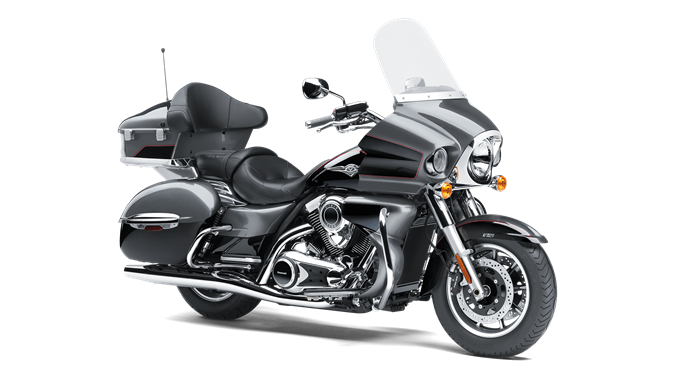
Pearl Storm Gray/Ebony
Click on a technology to learn more.
*Curb weight includes all necessary materials and fluids to operate correctly, full tank of fuel (more than 90 percent capacity) and tool kit (if supplied). When equipped, California evaporative emissions equipment adds approximately 2.2 lb.
KAWASAKI CARES: Read Owner's Manual and all on-product warnings. Always wear a helmet, eye protection and proper apparel. Never ride under the influence of drugs or alcohol. Adhere to the maintenance schedule in your Owner’s Manual. ©2024 Kawasaki Motors Corp., U.S.A.
Specifications subject to change.
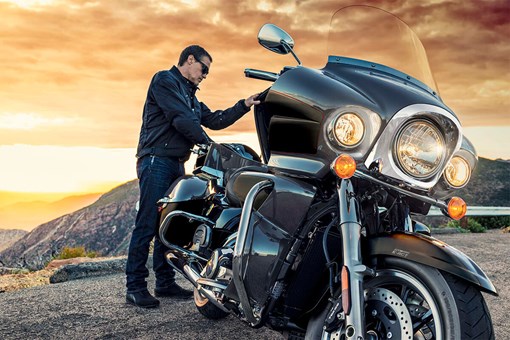
Pillow Top Gel Seat, Front

Saddlebag Liner Set

Trunk Liner

Vulcan ® Touring Dust Cover
Find a kawasaki dealer in your area.
Zip Code or City, State
Electronic Cruise Control
Electronic Throttle Valves
Electronic Cruise Control allows a desired speed (engine rpm) to be maintained with the simple press of a button. Once activated, the rider does not have to constantly apply the throttle. This reduces stress on the right hand when traveling long distances, enabling relaxed cruising and contributing to a high level of riding comfort.
Kawasaki’s fully electronic throttle actuation system enables the ECU to control the volume of both the fuel (via fuel injectors) and the air (via throttle valves) delivered to the engine. Ideal fuel injection and throttle valve position results in smooth, natural engine response and the ideal engine output. The system also makes a significant contribution to reduced emissions. Electronic throttle valves also enable more precise control of electronic engine management systems like S-KTRC and KTRC, and allow the implementation of electronic systems like KLCM, Kawasaki Engine Brake Control, and Electronic Cruise Control.
ABS (Anti-lock Brake System)
K-ACT (Kawasaki Advanced Coactive-braking Technology) ABS
Kawasaki ABS systems use front and rear wheel sensors to constantly monitor wheel speed. Should information from either of the sensors indicate that wheel lock has occurred, the ABS ECU directs the pump in the ABS unit to modulate brake fluid pressure (releasing and reapplying pressure so that traction can be regained) until normal operation resumes. ABS offers rider reassurance that contributes to greater riding enjoyment.
At its heart, K-ACT ABS is an advanced anti-lock braking system, designed to keep tires from locking up during braking. But K-ACT ABS was designed to be used on touring models weighing in excess of 300 kg (661 lb) – and that is before adding a passenger and luggage. Complementing its standard ABS function, K-ACT ABS links the front and rear brakes. It monitors the brake force the rider is exerting at both the front and rear, and takes into consideration vehicle speed to ensure highly effective braking while maintaining chassis stability. For example, let's say the rider pulls on the front brake lever. To keep the bike from pitching forward, the ABS ECU actuates the rear brake (via fluid pumps) to ensure that front-rear balance is maintained. Should the rider push the rear brake pedal, the system actuates the front brake as well to distribute the load more evenly so that the rear wheel does not lock up. Based on the vehicle speed, K-ACT decides the optimum hydraulic pressure to send to each caliper, ensuring that even with a heavy motorcycle, stable braking performance is possible.
Enter your email address so that we can find your existing information.
If you are currently subscribed, check your email for a secure link.
We're Sorry. There has been an error.

IMAGES
VIDEO
COMMENTS
Name: Kawasaki Voyager 1200 (Voyager XII) Code: ZG1200-B17 Specifications. Kawasaki ZG1200 Voyager XII: specs. Specifications DIMENSIONS Overall length 2815 mm / 110,8 in Overall width 965 mm / 38,0 in Overall height 1485 mm / 58,5 in Seat height 755 mm / 29,7 in Wheelbase 1620 mm / 63,8 in
The Kawasaki Z1300 is a standard motorcycle unusual for its large-displacement 1,300 cc straight-six engine made by Kawasaki from 1979 to 1989. Performance [ edit ] Kawasaki Z1300's length is 89.1 inches, and its width is 30.9 inches, its height: 49.8 inches, the wheelbase is 62.2 inches, seat height is 31.2 inches, ground clearance is 5.5 ...
Kawasaki turned to the Vulcan V-Twin line and the Vulcan Voyager 1700 (VN1700) was born - a modern, high-tech, high class, touring motorcycle in every sense of the word. The Voyager 1700 is the world's first Japanese V-Twin touring bike and reportedly produces 73 hp at 5,000 rpm, though Motor Cyclist Magazine's dyno tests showed 65.9 hp at 5000 ...
Kawasaki ZG 1200 Voyager XII: Year: 1992 - 93: Engine: Four stroke transverse four cylinder. DOHC, 4 valve per cylinder: Capacity: 1196 cc / 72.9 cu-in: Bore x Stroke: 78 x 62.6 mm: ... Kawasaki's Voyager is also the quickest in its class. The liquid-cooled, 16-valve, five-speed inline-four provides acceleration both from 0 to 60 mph and ...
And now. the 1989 1200. which is basically unchanged from the original model, is the only touring bike that Kawasaki officially offers, even though hardcore mass addicts can still find the discontinued Six at some dealers. What's most interesting about the Voyager XII is that even though it has two less cylinders, even though it weighs 150 ...
The Vulcan 1700 Voyager was Kawasaki's first V-Twin touring motorcycle ever. The big cruiser has a 1700cc fuel-injected engine that pumps out 73 horsepower. That is less than the Voyager XII ...
Kawasaki ZG 1200 Voyager XII Touring riders are supposed to be rich as Midas, with saddlebags full of money they're practically panting to spend. Maybe so, but for those of us with buying power a few clicks down, Kawasaki offers its Voyager. If you want proof by the numbers, try these figures on for size: At $8700, the Voyager is $1100 less ...
This is a list of Kawasaki motorcycles designed and/or manufactured by Kawasaki Heavy Industries Motorcycle & Engine and its predecessors. Special purpose. Kawasaki police motorcycles; ... ZG1200 Voyager XII (Four) ZN1300 Voyager XIII (Six) KE100 (produced 1976-2001) KE125; KL250A1/A2/A3/A4 (produced: 1978-1981)
The Voyager 1200, also known as the ZG1200 or Voyager XI/XII, was a touring motorcycle produced by Kawasaki from 1986 to 2003. Specs for the Kawasaki Voyager 1200 include: Engine Displacement: 1196cc. Cylinders/Engine Type: Transverse four cylinder liquid cool DOHC 4 stroke. Compression Ratio: 10:1. Transmission: 6 speed.
KAWASAKI ZG 1200 Voyager 1196. engine specs. Type: Liquid cooled, four stroke transverse four cylinder. DOHC, 4 valves per cylinder : Displacement: 1196 cm3: Bore X Stroke: 3x2.4 in OR 76 mm:
So pack the top-loading saddlebags and trunk. Then start up the 1,196cc In-Line Four DOHC engine, settle in behind the aerodynamic fairing and let dual gear-driven engine balancers and fully adjustable suspension provide an incredibly smooth ride. And head the Voyager XII toward the ParkWay's 469 miles of motorcycling paradise.
Name: Kawasaki Voyager 1300 (Voyager XIII) Frame: -JB503701 Code: ZN1300-A6 Specifications. Kawasaki ZN1300 Voyager: specs. Specifications DIMENSIONS Overall length 2595 mm / 102,2 in Overall width 960 mm / 37,8 in Overall height 1580 mm / 62,2 in Seat height 757 mm / 29,8 in Wheelbase 1645 mm / 64,8 in
Kawasaki ZG 1200 Voyager XII is produced in 1986-88. Engine is Four stroke transverse four cylinder. DOHC, 4 valve per cylinder, displacement 1196 cc / 72.9 cu-in , produces power 97 hp / 72.3 kW @ 7000 rpm and 11.0 kgf-m / 79.5 lb-ft @ 5000 rpm. Kawasaki ZG 1200 Voyager XII weighs 317 kg / 698.9 lbs. Kawasaki ZG 1200 Voyager XII has 1 photos.
The Kawasaki H1 Mach III in 1968, along with several enduro -styled motorcycles to compete with Yamaha, Suzuki and Honda, increased sales of Kawasaki units. 1974 saw the establishment of a Kawasaki assembly facility in Lincoln, Nebraska, US, named the American Kawasaki Motors Corporation (KMC), to complete Japan-produced components into ...
Yamaha Venture Royale 1300. Kawasaki ZG1200 Voyager based on an in-line 4-cylinder liquid-cooled engine with a volume of 1196 cc. see, giving out 97 hp. power and 108 Nm of torque. The maximum performance of the motor is reached at 5000-7000 rpm.
Kawasaki ZG1200 Voyager, 2003: Photo Gallery, Video, Specs, Features, Offers, Similar Models and More.
Motorcycle reviewed 2003 Kawasaki Voyager XII. My brother has a Goldwing 1500 and it isn't as good compared to a Voyager 1200. Voyager is faster, better looking and easier to work on, too. It will out-run Goldwing hands down and it's smooth. It's great in the twisties and even better on the interstate slab 45-50 mpg.
The 6-speed transmission includes overdrive and positive neutral finder. The Kawasaki Vulcan Voyager is a cruising bike that includes electronic cruise control. You can activate it in 3 rd gear or between speeds of 30 mph to 85 mph. The braking system is also high tech with Kawasaki ingenuity. The ABS system ensures ideal brake force distribution.
The Vulcan 500 (EN500A) introduced in 1990 was the successor to the Kawasaki 454 LTD. The EN500A was fitted with a parallel twin 498 cc engine nearly identical to the Kawasaki Ninja 500R. It had a 6-speed transmission and belt final drive. The EN500A was discontinued after 1996 and replaced with the Vulcan 500 LTD (EN500C).
The Kawasaki Vulcan 1700 Voyager takes the comforts of the cruise and pairs it with a long-stroke 1,700cc V-twin with peak torque low in the rev range—that's a claimed 108.0 pound-feet at ...
The Vulcan ® 1700 Voyager ® is the king of Kawasaki touring cruisers. A 1,700cc digitally fuel-injected V-twin engine plus Kawasaki Advanced Coactive-braking Technology (K-ACT) ABS and electronic cruise control help make the Vulcan 1700 Voyager the pinnacle of power and luxury on the open road.
The Vulcan® 1700 Voyager® aBS motorcycle is one of those rare machines. It offers a stylish alternative to run-of-the-mill V-twin tourers, combining Kawasaki reliability with the performance, V-twin feel, comfort and amenities that a long-distance touring rider and passenger demand. (1) KAWASAKI 1200 XII. (2) KAWASAKI ABS.
The 2023 Kawasaki Vulcan® 1700 Voyager® ABS cruiser is the pinnacle of power and luxury, featuring stylish frame mounted fairings and a massive 1,700cc fuel-injected, V-twin engine. ... Kawasaki's fully electronic throttle actuation system enables the ECU to control the volume of both the fuel (via fuel injectors) and the air (via throttle ...